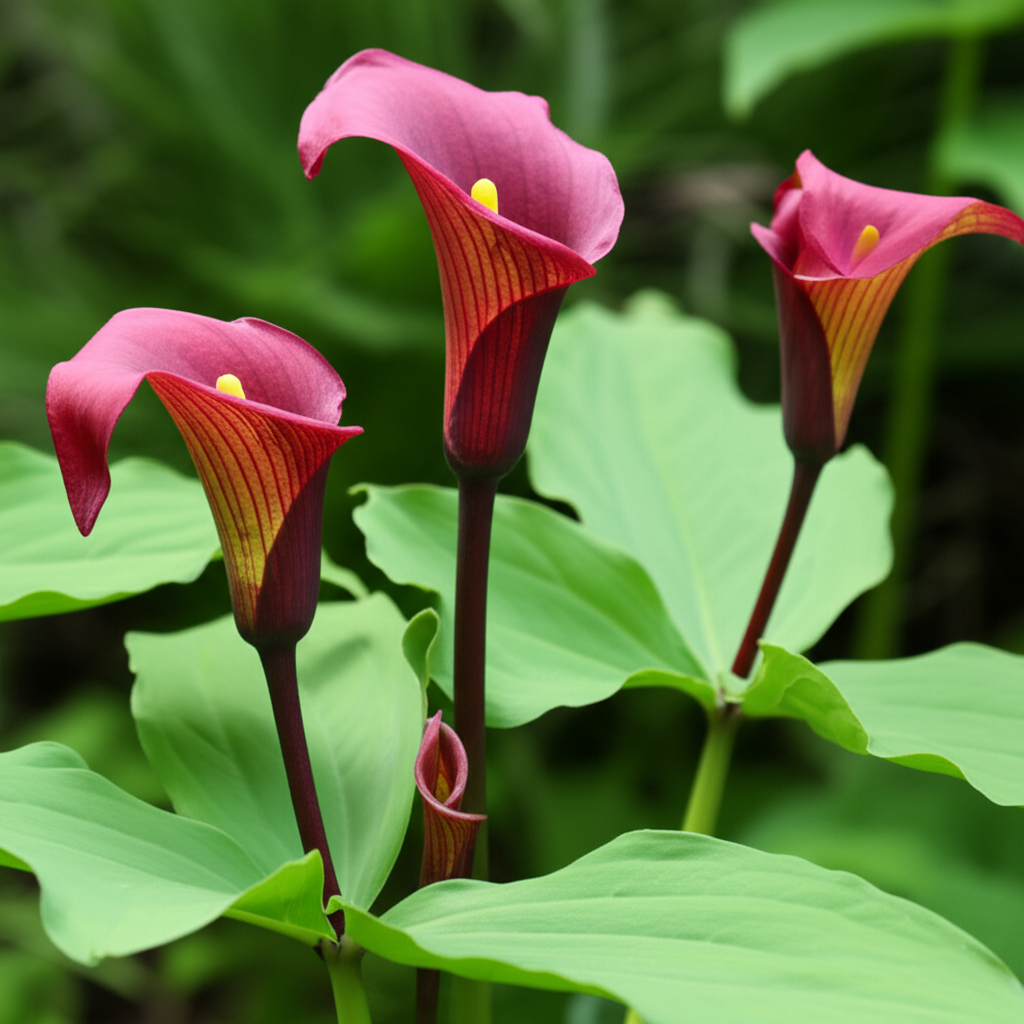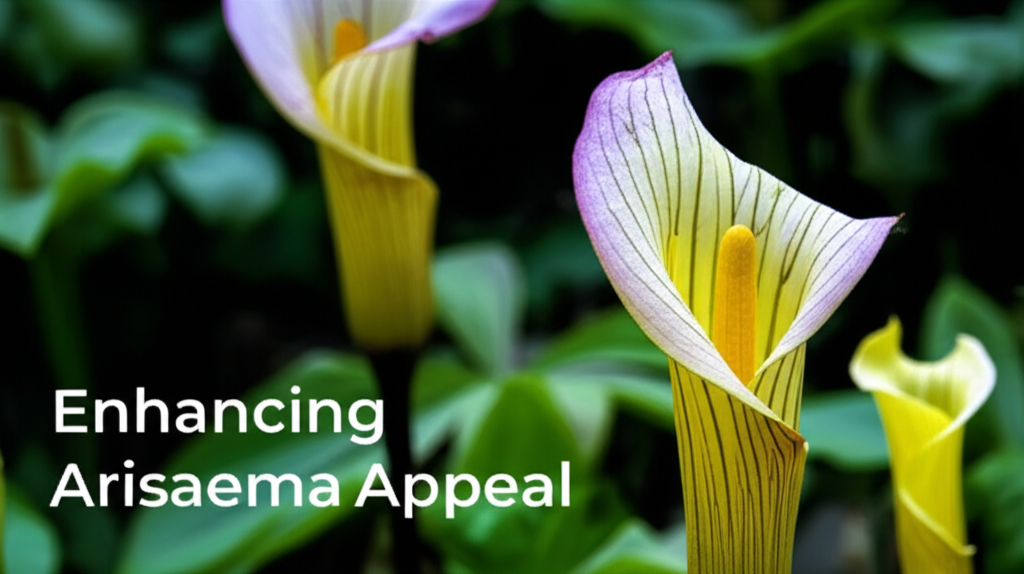Unveiling the Magic of the Jack-in-the-Pulpit
The Jack-in-the-Pulpit (Arisaema triphyllum) is a woodland wildflower that captivates with its unique and enigmatic beauty. Its distinctive structure, resembling a preacher at a pulpit, with a hooded spathe protecting the spadix, makes it a perennial favorite among gardeners and nature enthusiasts. However, to truly showcase this botanical marvel, thoughtful display enhancement techniques are essential. This article delves into strategies that will elevate the visual appeal of your Jack-in-the-Pulpit, transforming a simple planting into a captivating focal point within your garden.
Understanding the Jack-in-the-Pulpit’s Natural Habitat and Needs

Before we embark on enhancement techniques, a foundational understanding of the Jack-in-the-Pulpit’s natural requirements is paramount. Mimicking its native woodland environment will not only ensure the plant’s health and longevity but also provide the ideal backdrop for its display.
Ideal Growing Conditions
- Shade: Jack-in-the-Pulpits thrive in dappled shade or partial shade. Direct, scorching sun can damage their delicate foliage.
- Moisture: They prefer consistently moist, well-drained soil. Avoid waterlogged conditions, which can lead to root rot.
- Soil Type: Rich, humusy soil is ideal. Incorporating compost and other organic matter will significantly improve soil structure and fertility.
- pH: A slightly acidic to neutral soil pH is generally preferred.
Growth Cycle and Seasonal Interest
Understanding the plant’s life cycle is key to planning its display.
- Spring Emergence: The plant emerges in early to mid-spring, with the distinctive spathe and spadix forming before the leaves fully unfurl. This is a period of high visual interest.
- Summer Foliage: Once the flowering structure has completed its duty, the attractive, trifoliate leaves take center stage, providing lush greenery throughout the summer months.
- Fall Berry Display: After the foliage begins to yellow, bright red or sometimes greenish berries form on the spadix, offering a secondary burst of color.
Key Facts and Comparison of Display Enhancement Approaches
To effectively enhance the display of your Jack-in-the-Pulpit, consider a variety of approaches, each offering unique benefits. The following table outlines key facts and compares different enhancement strategies.
| Feature | Naturalistic Woodland Planting | Container Gardening | Mixed Perennial Borders | Specimen Planting |
|---|---|---|---|---|
| Primary Goal | Recreate natural beauty, harmonious integration | Controlled environment, portability, focused view | Companionship, seasonal interest, mass appeal | Highlighting individual specimen, architectural focus |
| Ease of Implementation | Moderate (requires understanding of woodland ecology) | Easy to Moderate (requires container selection and watering management) | Moderate (requires plant selection and design) | Easy (requires good location selection) |
| Maintenance Level | Low to Moderate (natural regeneration, occasional weeding) | Moderate to High (regular watering, potential repotting) | Moderate (pruning, deadheading, pest/disease monitoring) | Low to Moderate (occasional watering, mulching) |
| Visual Impact | Subtle, harmonious, integrated | Bold, focused, architectural | Dynamic, layered, ever-changing | Striking, singular, dramatic |
| Best For | Woodland gardens, shaded areas, naturalistic designs | Patios, decks, balconies, small spaces, seasonal displays | Mixed flower beds, pollinator gardens, cottage gardens | Entryways, focal points, small urban gardens |
Enhancement Techniques: A Deeper Dive
Now, let’s explore specific techniques to maximize the visual impact of your Jack-in-the-Pulpit.
1. Strategic Companion Planting
The Jack-in-the-Pulpit rarely stands alone in its natural habitat. Companion planting creates a more visually rich and ecologically balanced display.
Woodland Understory Companions
These plants not only complement the Jack-in-the-Pulpit aesthetically but also share similar growing requirements.
- Ferns: Delicate fronds of various ferns (e.g., Lady Fern, Ostrich Fern) provide a verdant, textural contrast that enhances the Jack-in-the-Pulpit’s form. Their shade tolerance is a perfect match.
- Hostas: Hosta varieties with variegated or textured foliage can offer a subtle backdrop and visual interest throughout the growing season, especially when the Jack-in-the-Pulpit’s leaves begin to fade.
- Wild Ginger (Asarum canadense): Its low-growing, heart-shaped leaves create a lush groundcover that complements the upright structure of the Jack-in-the-Pulpit.
- Trilliums: These classic woodland wildflowers bloom around the same time, adding splashes of color (white, pink, red) to the early spring display.
- Foamflower (Tiarella cordifolia): Its delicate, foamy white flower spikes provide a soft, ethereal quality that pairs beautifully with the Jack-in-the-Pulpit’s more structured bloom.
Seasonal Interest Companions
- Spring Bulbs: Early spring bulbs like Snowdrops (Galanthus nivalis), Scilla (Scilla spp.), and miniature Daffodils (Narcissus spp.) can provide color before the Jack-in-the-Pulpit fully emerges, creating a layered spring display.
- Summer Bloomers: While the Jack-in-the-Pulpit’s bloom is ephemeral, surrounding plants like Bleeding Hearts (Dicentra spectabilis) and Columbine (Aquilegia spp.) can extend the visual appeal into late spring and early summer.
2. Container Gardening for Focused Display
Growing Jack-in-the-Pulpits in containers offers a unique opportunity to control their environment and place them strategically for maximum impact.
Container Selection
- Material: Terracotta, ceramic, or weathered wood containers lend a natural aesthetic. Avoid brightly colored plastic unless it’s integrated into a specific design theme.
- Size: Choose a container deep enough to accommodate the corm and provide ample room for root growth. A minimum depth of 8-10 inches is recommended.
- Drainage: Excellent drainage is crucial. Ensure containers have adequate drainage holes.
Potting Mix and Care
- Use a well-draining potting mix, incorporating compost and perlite for aeration.
- Water regularly to keep the soil consistently moist but not waterlogged.
- Place containers in a location that receives dappled shade.
- Consider overwintering containers in a cool, protected location, especially in colder climates.
Strategic Placement of Containers
- Entryways: A well-placed container near an entrance can greet visitors with the plant’s unique charm.
- Patios and Decks: Bring the woodland beauty to your outdoor living spaces.
- Focal Points: Grouping several containers can create a striking focal point on a patio or in a garden nook.
3. Mulching for Aesthetics and Health
Mulch is a fundamental element in both enhancing the visual appeal and improving the growing conditions for Jack-in-the-Pulpits.
Types of Mulch
- Shredded Bark or Wood Chips: These provide a natural, woodland-like appearance and effectively suppress weeds.
- Leaf Mold: Decomposed leaves create a rich, dark mulch that is excellent for soil health and complements the naturalistic aesthetic.
- Pine Needles: These can help to acidify the soil slightly, which is beneficial for some woodland plants, and offer a rustic look.
Benefits of Mulching
- Moisture Retention: Mulch helps to retain soil moisture, reducing the need for frequent watering.
- Temperature Regulation: It insulates the soil, keeping roots cooler in summer and warmer in winter.
- Weed Suppression: A thick layer of mulch can significantly reduce weed growth, minimizing competition for nutrients and water.
- Aesthetic Appeal: A well-maintained mulch layer unifies the planting area and provides a clean, finished look.
4. Illuminating the Display
For gardens that are enjoyed in the evening, strategic lighting can dramatically enhance the Jack-in-the-Pulpit’s enigmatic presence.
Low-Level Garden Lighting
- Uplighting: Placing small spotlights at the base of the plant, aimed upwards, can cast dramatic shadows and highlight the unique structure of the spathe and spadix.
- Path Lights: Low-level path lights can subtly illuminate the planting area, guiding the eye and creating a magical ambiance.
- Moonlighting: Hanging lights in nearby trees can simulate moonlight, casting a soft, diffused glow that enhances the woodland feel.
Considerations for Lighting
- Use low-voltage, energy-efficient lighting.
- Ensure lights are strategically placed to avoid harsh glare.
- Consider the plant’s natural cycle; lighting may be most effective during its spring bloom or when the berries are present.
5. Creating a Sense of Place: The Japanese Garden Influence
The principles of Japanese garden design can offer valuable insights into showcasing the Jack-in-the-Pulpit’s inherent beauty. This approach emphasizes simplicity, asymmetry, and the use of natural elements.
Key Principles
- Asymmetry: Avoid rigid, formal arrangements. Allow for a more natural, organic flow.
- Negative Space: The art of “ma” (empty space) is crucial. Don’t overcrowd the Jack-in-the-Pulpit. Allow it room to breathe and be appreciated.
- Natural Materials: Incorporate elements like moss-covered rocks, driftwood, or natural stone pathways to enhance the woodland feel.
- Water Features (Optional): A small, trickling water feature nearby can add an auditory and visual element of tranquility.
Application for Jack-in-the-Pulpit
- Plant a single specimen near a weathered stone or a piece of mossy wood.
- Surround the area with a delicate layer of moss or fine gravel.
- Ensure surrounding plants are subdued and do not detract from the Jack-in-the-Pulpit.
Steps for Implementing Display Enhancement Techniques
The following steps provide a structured approach to enhancing your Jack-in-the-Pulpit display.
| Step | Description | Key Considerations |
|---|---|---|
| 1. Site Assessment | Evaluate light, soil moisture, and existing garden elements. | Shade requirement, drainage, soil type. |
| 2. Plant Selection & Sourcing | Choose healthy specimens, considering desired companions. | Reputable nurseries, local provenance (if possible). |
| 3. Soil Preparation | Amend soil with organic matter for optimal growth. | Compost, leaf mold, well-draining mix. |
| 4. Planting Strategy | Determine placement based on desired effect (specimen, companion, container). | Spacing, grouping, focal points. |
| 5. Companion Planting Integration | Introduce complementary species that share similar needs. | Textural contrast, seasonal interest, color harmony. |
| 6. Mulching Application | Apply a layer of organic mulch around the plant. | Type of mulch, thickness (2-3 inches). |
| 7. Watering Regimen | Establish a consistent watering schedule, especially during dry periods. | Check soil moisture regularly. |
| 8. Lighting (Optional) | Install low-voltage lighting for evening viewing. | Uplighting, path lights, safety. |
| 9. Ongoing Maintenance | Weeding, monitoring for pests/diseases, occasional fertilization (if needed). | Observe plant health, address issues promptly. |
Pros and Cons of Different Enhancement Approaches
Each enhancement technique comes with its own set of advantages and disadvantages. Weighing these will help you choose the most suitable strategies for your garden.
| Approach | Pros | Cons |
|---|---|---|
| Companion Planting | Enhances naturalistic appeal, supports biodiversity, provides layered interest, can deter pests. | Requires careful selection to avoid competition, can be challenging to achieve balance. |
| Container Gardening | Flexibility in placement, controlled environment, portability, ideal for small spaces. | Requires more frequent watering, potential for root-bound plants, needs overwintering in colder climates. |
| Mulching | Improves soil health, conserves moisture, suppresses weeds, enhances aesthetics. | Can harbor slugs and snails if not managed properly, requires replenishment. |
| Strategic Lighting | Extends viewing enjoyment into the evening, creates dramatic effect, highlights unique features. | Requires electrical installation, can be costly, potential for light pollution if not done carefully, may disturb nocturnal wildlife. |
| Japanese Garden Principles | Promotes tranquility, emphasizes natural beauty, creates a serene atmosphere. | Requires a certain aesthetic sensibility, can be perceived as minimalist by some. |
Conclusion: Cultivating a Captivating Jack-in-the-Pulpit Display
The Jack-in-the-Pulpit is more than just a plant; it is a botanical enigma that deserves to be showcased with intention and care. By understanding its needs, embracing thoughtful companion planting, leveraging the versatility of containers, and employing aesthetic enhancement techniques like mulching and strategic lighting, you can transform your Jack-in-the-Pulpit into a true garden spectacle. Whether integrated into a lush woodland setting or highlighted as a singular specimen, these techniques will ensure that this captivating wildflower receives the admiration it so richly deserves, drawing the eye and sparking wonder in all who behold it.


